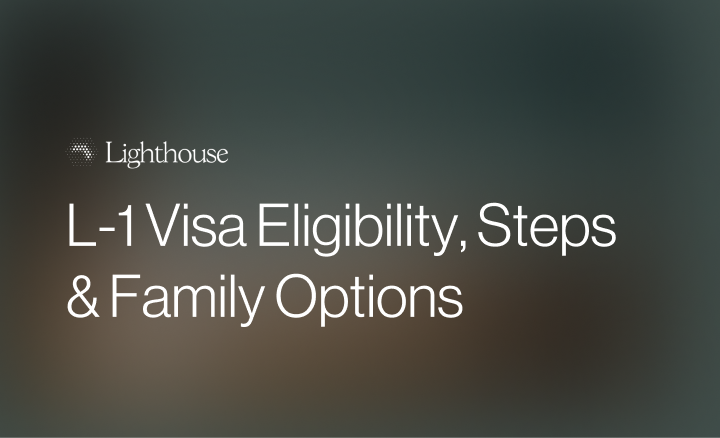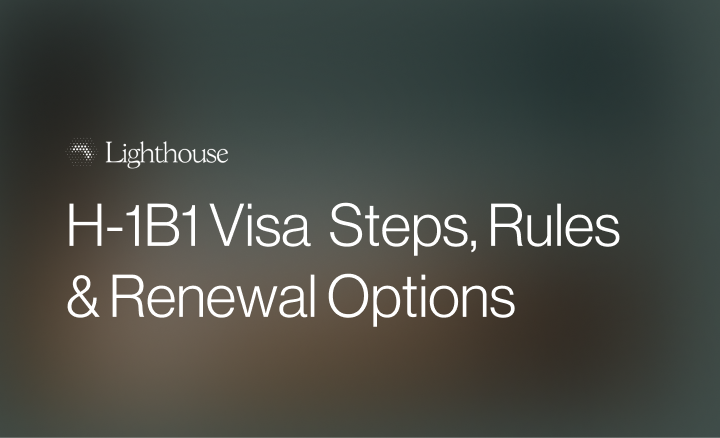The O‑1A Visa Explained
Your complete guide to the O-1A visa for extraordinary professionals.


If you are a scientist, entrepreneur, educator, or athlete with extraordinary ability in your particular field, the O‑1A visa may allow you to work in the United States.
This guide outlines how the visa process works, who qualifies, and how Lighthouse helps skilled professionals navigate the U.S. immigration process with accuracy and confidence.
What is the O‑1A visa?
The O‑1A visa is a U.S. nonimmigrant visa for individuals who can demonstrate extraordinary ability in science, education, business, or athletics. It is intended for those who have achieved international recognition at a level significantly above the ordinary and are coming to the United States to work in their area of expertise.
The program is administered by U.S. Citizenship and Immigration Services (USCIS), part of the Department of Homeland Security. Full official regulations can be found on the USCIS O‑1 visa page.
Lighthouse supports qualified professionals, founders, and researchers through each step of the O‑1 application, from O-1 eligibility screening to evidence organization and legal review.
Eligibility criteria
To qualify for the O‑1A visa, you must show extraordinary ability as defined under 8 CFR 214.2(o). You can meet this requirement in one of two ways:
1. Major internationally recognized award
Evidence of a one‑time achievement, such as a Nobel Prize, Emmy, Olympic medal, or another internationally recognized honor, can meet the standard outright.
However, most applicants do not fall into this first category. Unless you have received a major international award, you will need to demonstrate that you meet at least three of the following criteria.
2. Alternative evidence, at least three of the following:
- Critical Role at a Distinguished Organization: Employed in a critical or essential capacity for organizations and establishments that have a distinguished reputation
- High Remuneration: Commanded a high salary or will command a high salary or other remuneration for services, as evidenced by contracts or other reliable evidence
- Membership: Membership in associations that require outstanding achievements, as judged by recognized national or international experts in their disciplines or fields
- Published Materials: Published material in professional or major trade publications or major media about the beneficiary, relating to the beneficiary’s work
- Award: Receipt of nationally or internationally recognized prizes or awards for excellence in the field of endeavor
- Judging: Participation on a panel, or individually, as a judge of the work of others in the same or in an allied field of specialization
- Original Contributions of Major Significance: Original scientific, scholarly, or business‑related contributions of major significance in the field
- Authorship: Authorship of scholarly articles in the field, in professional journals, or other major media. Comparable evidence may be accepted if one or more criteria do not apply to your field.
Examples of qualifying professionals
- A biotech founder whose startup has received venture funding and global media coverage
- A university researcher with multiple peer‑reviewed publications and citations
- An athlete or coach with national championship experience and endorsements
- A business executive who has led high‑growth or internationally recognized projects
For a deeper breakdown of regulatory language, see the USCIS section on O‑1A evidentiary criteria.
The application process
The O‑1A is a petition‑based visa, meaning a U.S. employer, agent, or organization must file the O-1 petition on your behalf. Self‑sponsorship is not permitted.
Step 1: Employer or agent files Form I‑129
- The petitioner (U.S. employer or agent) submits Form I‑129, Petition for a Nonimmigrant Worker, to USCIS.
- The petition must include:
- A written advisory opinion from a peer group or management organization verifying your extraordinary ability;
- Copies of contracts or offer letters detailing terms of employment;
- A project itinerary if multiple engagements are planned;
- Supporting documentation proving your international acclaim and relevant achievements.
Petitions can be filed up to one year before the intended start date, but should reach USCIS at least 45 days before employment begins.
Official instructions are on the Form I‑129 page.
Step 2: USCIS review
USCIS examines the petition, reviews the evidence, and may issue a Request for Evidence (RFE) if clarification or additional proof is needed. Once approved, USCIS sends the petitioner Form I‑797, the Notice of Action.
Step 3: Apply for the visa
If you are outside the U.S., use the approved petition to apply for your visa at a U.S. embassy or consulate via Form DS‑160 on the Department of State’s website.
At the interview, bring:
- A valid passport
- Form I‑797 approval notice
- DS‑160 confirmation page
- Proof of your credentials and achievements
Once approved, you’ll receive the visa stamp allowing entry to the U.S.
Step 4: Entering the United States
You may arrive up to 10 days before your employment start date, but cannot begin work until that date. Customs and Border Protection (CBP) will issue your I‑94 record showing your authorized period of stay.
Visa validity and extensions
Given that O‑1A projects often span multiple years, it is important to understand how long the status lasts and how to maintain it.
- Initial validity: up to 3 years, covering the time required to complete the event or project.
- Extension of stay: available in one‑year increments to continue or finish the same activity.
- Grace period: up to 10 days before and 10 days after authorized employment to enter or depart; additionally, USCIS may grant a 60‑day grace period after job termination.
Applications for extensions follow the same Form I‑129 process with updated documentation.
Fees
Every petition involves specific government filing fees and optional costs that applicants and sponsors should budget for in advance.
According to USCIS.gov, these fees incluse:
- Form I‑129 filing fee: $460
- Asylum Program Fee: $600 (for employers with more than 25 employees; smaller employers are exempt)
- Premium Processing (Form I‑907): $2,805 (optional, 15‑day decision)
- Consular application fee (Form DS‑160): $205
Additional costs may include translation services or courier delivery. See Investopedia’s explanation of USCIS filing fees for an overview of fee structures.
Dependents and families of O‑1A and O‑2 visa holders
Many professionals travel with family or key staff, and the O‑1A framework provides pathways for both categories.
O‑3 dependents
Spouses and unmarried children under 21 can apply for O‑3 visas.
- O‑3 holders may study in the United States but cannot work.
- Their status is contingent on the main O‑1 holder’s status.
- They apply using the principal’s Form I‑797 approval and their own DS‑160 at the U.S. embassy.
O‑2 support personnel
Some O‑1A roles, particularly in athletics or the television industry, require essential support staff. Those individuals may qualify for O‑2 visas if they possess specialized knowledge critical to the primary applicant’s work and are not readily available in the U.S. workforce.
Processing times
Processing can vary by workload and location, but typical averages are:
Premium Processing expedites USCIS’s adjudication but not the consular interview stage.
O‑1A vs. O‑1B vs. H‑1B
O‑1A isn’t the only path for experts or high‑achievers, seeing how it compares with the O‑1B visa (arts, motion picture, or television field) and H‑1B visa (specialty occupations) helps clarify its advantages.
Changing employers or adding new projects
Given the complexity and documentation required, professional guidance can make a measurable difference in outcomes. O‑1A employment is employer‑specific. You may work only for the petitioner listed in your approved I‑129. If you intend to:
- Accept a role with a new employer, or
- Add separate projects not covered under the existing petition,
The new employer or agent must file a new or concurrent O‑1 petition with supporting documents. Any material change in employment (such as job title, duties, or location) requires an amended petition.
Return transportation requirements
If an O‑1A employee is terminated for reasons other than voluntary resignation, the employer or agent must pay the cost of return transportation to the worker’s last place of residence abroad.
This rule applies only to the petitioner who sponsored the O‑1A petition and does not cover dependents or self-initiated termination.
See the CFR provision on return transportation at 8 CFR 214.2(o)(18).
Long‑term options and green card pathways
While the O‑1A is a temporary nonimmigrant status, many holders later apply for permanent residence through the EB‑1A (Extraordinary Ability) or EB‑2 NIW (National Interest Waiver) categories.
These immigrant visas allow self‑petition and do not require employer sponsorship. Maintaining O‑1 status while filing a green card case is permissible; the O‑1A is considered “dual‑intent‑friendly” by USCIS.
Key Takeaways
The O‑1A visa enables individuals with extraordinary ability in science, business, education, or athletics to work in the United States through a petition filed by a U.S. employer or agent. It is valid for up to three years and extendable in one‑year increments.
Dependents qualify for O‑3 visas, which allow study but not employment. Premium processing can shorten approval to fifteen days, and O‑1A status can later support an EB‑1A or EB‑2 NIW green card application.
Choosing the right support partner
Preparing a strong O‑1A petition requires careful organization, clear documentation of international acclaim, and compliance with every USCIS standard. Errors (even minor ones) can delay or derail approval.
Lighthouse combines technology and expert case guidance to simplify complex immigration filings for skilled professionals:
- Free eligibility evaluation before you start
- Personalized onboarding and document preparation checklist
- Dedicated case management from start to stamping
- Legal review of petitions prior to USCIS submission
- Transparent pricing and faster turnaround times
Join engineers, researchers, entrepreneurs, and executives who trust Lighthouse to navigate the O‑1A visa process with clarity and compliance.
Fill out our eligibility form to see how Lighthouse accelerates your visa application.
Frequently asked questions
Who can sponsor an O‑1A visa?
A U.S. employer, U.S. agent, or foreign employer through a U.S. agent can act as the petitioner. Self‑petition is not permitted under O‑1A regulations.
Can founders or startup entrepreneurs qualify?
Yes. Startup founders can be eligible if they can demonstrate sustained international recognition through funding rounds, accelerator participation, press coverage, or leadership in a company of distinguished reputation.
What happens if my job ends early?
USCIS usually grants a discretionary 60‑day grace period or until your I‑94 expires, whichever is shorter. During this time, you can file a new O‑1 petition with a new sponsor or prepare to depart.
Can I work for multiple employers?
Yes, if each engagement is covered by its own approved O‑1 petition or concurrent filing through a qualified agent listing all authorized projects.
Can my O‑3 dependents work in the United States?
No. O‑3 dependents may study but cannot obtain employment authorization. To work, they must change status to another eligible visa category.
How long does O‑1A processing take with Premium Processing?
Premium Processing guarantees USCIS adjudication within 15 calendar days, though consular interview wait times depend on the specific U.S. embassy or consulate.
Do O‑1 visa holders need to maintain documentation after approval?
Yes. You should keep copies of contracts, advisory opinions, published material, and performance evidence to prove continuing eligibility during extensions or future applications.
Can O‑1A visa holders apply for a green card?
Yes. Many transition to permanent residence through EB‑1A or EB‑2 NIW petitions while maintaining a valid O‑1 status.
Lighthouse provides expert guidance and legal review to strengthen your case.

%201.svg)



